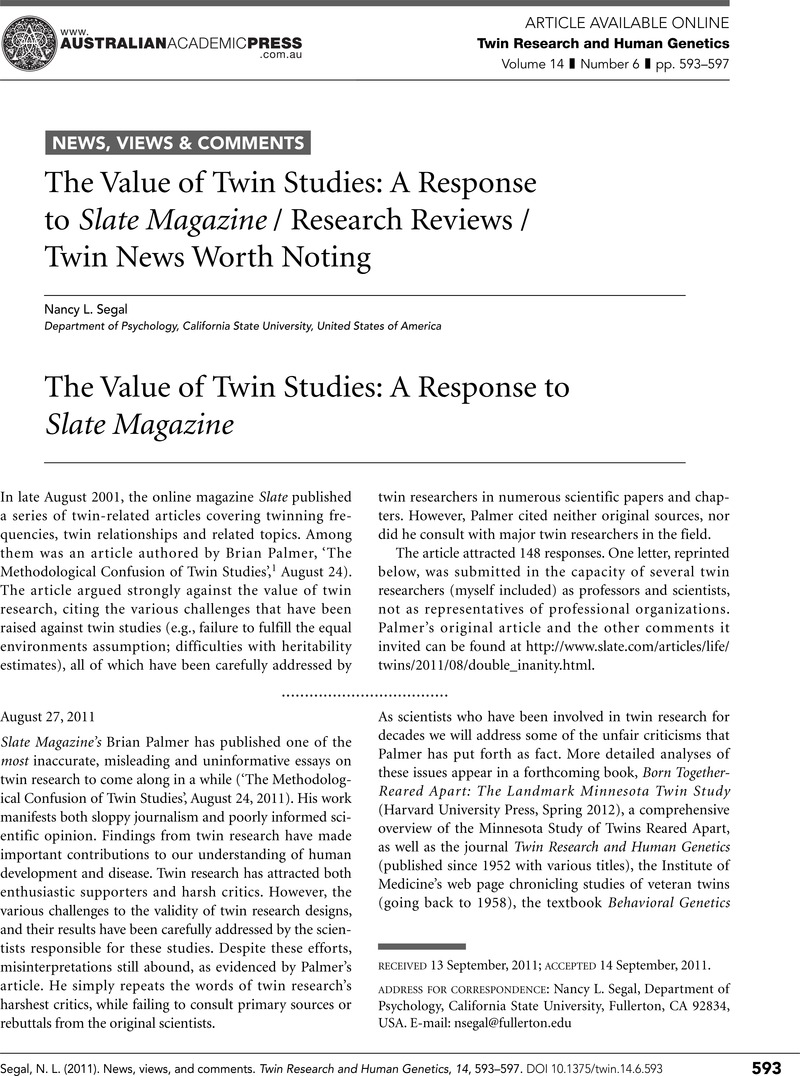No CrossRef data available.
Article contents
The Value of Twin Studies: A Response to Slate Magazine / Research Reviews / Twin News Worth Noting
Published online by Cambridge University Press: 21 February 2012
Abstract
An abstract is not available for this content so a preview has been provided. As you have access to this content, a full PDF is available via the ‘Save PDF’ action button.

- Type
- News, Views, and Comments
- Information
- Copyright
- Copyright © Cambridge University Press 2011
References
Byrnes, I., & Stenzel, A. (2007). The power of two: A twin triumph over cystic fibrosis. Columbia: University of Missouri Press.Google Scholar
Colacello, B. (2011, September). The age of elegance. Vanity Fair, 613, 326–333; 352–353.Google Scholar
Gutpa, P., Farida, M. M. A., & Batra, M. (2011). Physiological skin manifestations in twins: Association with maternal and neonatal factors. Pediatric Dermatology, 28, 387–392.Google Scholar
Lacey, M. (2011, August 8). Identical twins, one charged in a fatal shooting, create confusion for the police. New York Times. Retrieved August 9, 2011, from http://www.nytimes.com/2011/08/09/us/09twins.htmlGoogle Scholar
Maggioni, F., Mainardi, F., Bellamio, M., & Zanchin, G. (2011). Transient global amnesia triggered by migraine in monozygotic twins. Headache, 51, 1305–1308.CrossRefGoogle ScholarPubMed
Padawer, R. (2011, August 14). The two-minus-one pregnancy. New York Times Magazine, pp. 22–27.Google Scholar
Palmer, B. (2011, August 24), Double inanity: Twin studies are pretty much useless. Slate Magazine. Retrieved from http://www.slate.com/id/2301906/Google Scholar
PubMed Health. (2011). Milia. A.D.A.M. Medical Encyclopedia. Retrieved from http://www.ncbi.nlm.nih.gov/pubmed-health/PMH0002343/Google Scholar
Wyatt, W. J., & Midkiff, D. M. (2006). Biological psychiatry: A practice in search of a science. Behavior and Social Issues, 15, 132–151.CrossRefGoogle Scholar
Wyatt, W. J., & Midkiff, D. M. (2007). Psychiatry's thirty-five year, non-empirical reach of biological explanations. Behavior and Social Issues, 16, 197–213.CrossRefGoogle Scholar


